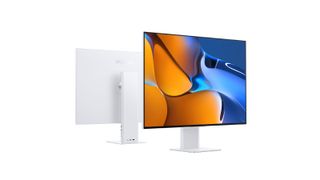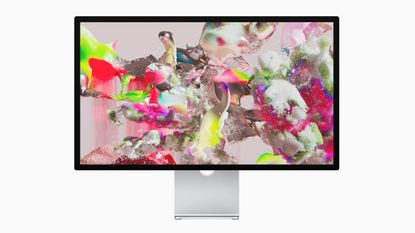At the spring Apple Event (catch up with all the news here), the company unveiled a new monitor: the Apple Studio Display. I was so hoping Apple would announce something like this, and the core spec is exactly what I wished for: a 27-inch 5K display with high brightness.
I'm re-doing my home office after a house move, and I basically had my wallet open ready for this… and yet, I'm not going to buy it. It's partly to do with the price being too high (as we'll come to in a moment), and partly because I've also had my eye on a rival with similar specs but big-screen twist, and now that we know the prices, the other screen is the winner for me.
So, the price of the Apple Studio Display is £1,499/$1,599/AU$2,499 – but I want it with the height-adjustment stand, because I'm tall, my partner is not, and no one wants to develop neck issues. This is a standard feature on many cheap monitors, but adds another £400/$400/AU$600 to the price here. So here in the UK, I'm looking at £1,899 for the screen I want…
If I was going to spend that much on a display of this quality, I might as well buy the iMac 24-inch (2021), which starts from £1,249 and comes with an entire Mac in it as a bonus!
To be fair, the Studio Display also has a computer in it, in the form of an Apple A-series chip that powers a smart webcam and Dolby Atmos speakers… but I'm struggling with seeing these as enough of a benefit for the price.
I really hoped that this display would come in under the £1,000/$1,000 mark – and I'd have been very tempted by that, because the quality of Apple's screens is just so good. As much as I'm griping about Apple's pricing, it's worth noting that most displays at this size, at this high resolution, rarely hit the brightness levels that Apple's offering (600 nits in the Studio Display). It's so much easier to see what you're doing without reflection and with colour clarity in a brighter screen – and the Studio Display is for pros. For creatives with a budget, the price is justifiable.
But it means that Apple has priced me out, ultimately. But also, I've already had my head turned by the Huawei MateView display instead – and not just because the price is a third of the Studio Display's. For £500, you get a 28-inch 4K display, 500 nits of brightness, P3 colour support and USB-C hub connectivity – all of which I'm very happy with.
But the display isn't the usual widescreen aspect ratio. Instead of 16:9 (which is standard for monitors), it's 3:2 – which means the resolution is 3840x2560. So it's like having a 4K resolution screen with a load of extra height.

Here's the Huawei MateView – taking a page from Apple's book in the design department, but with added height!
I'm of the opinion that actually a huge number of us would be better off with a display that's less widescreen. I work on a website CMS and in documents, including lengthy spreadsheets – adding some extra height to my screen makes my life easier in the simplest and most direct way: I can see more at once!
So many people's computer work is ultimately focused on documents or forms and so on most of the time, and a bit of extra height could be surprisingly transformative.
Apple made an expensive display that added innovative new features, but not in the right areas for me. The Huawei MateView adds value a very simple way: more space to work. So while I was ready for Apple to win me over, it's the strange square-ish screen I'll be going with.



